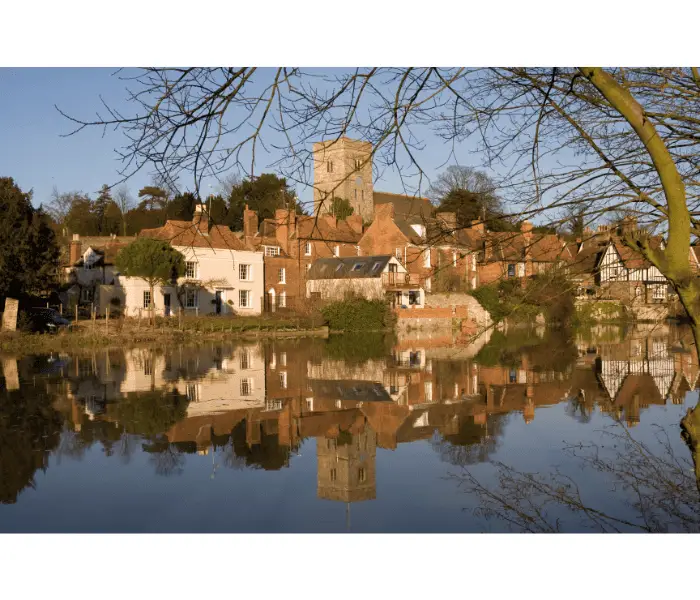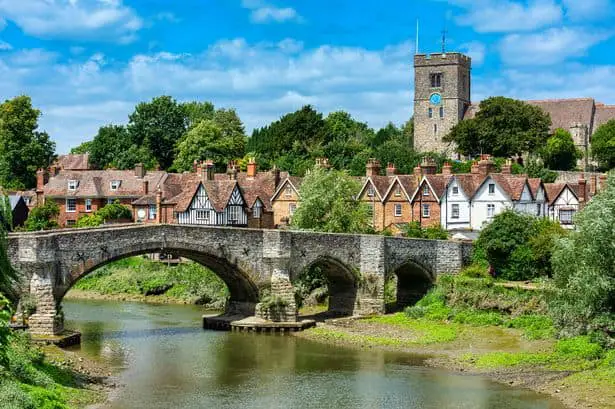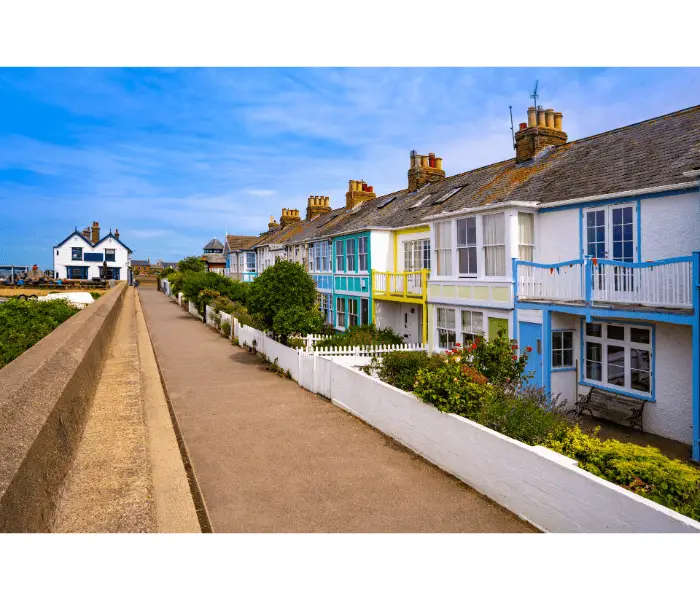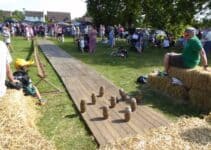Few counties exude traditional English charm like Kent. Situated in southeast England, it’s home to notable villages, towns and cities, such as Canterbury, Maidstone, and Dover.
But that’s not what we’re here to discuss. Instead, we’ll be looking at 10 of the prettiest villages in Kent. Villages are generally the best place to see an area’s true potential because they often stick with their traditional nature.
So, here are 10 of the prettiest villages in Kent.
Prettiest Villages in Kent
In no particular order, let’s go through the most popular Kent villages looking at why they’re so appealing.
1. Chiddingstone
The settlement of Chiddingstone began before the 10th century, although the exact date is unclear. It’s home to some of the oldest buildings in Kent and is owned (and protected) by the National Trust.
Chiddingstone is the only village in the UK that’s majority-owned by the National Trust, which is to protect its Tudor heritage.
As you can imagine, there are plenty of timber-frame houses and quaint cottages, along with a few pubs and tearooms. You can visit Chiddingstone Castle in the summer, which is well worth a visit if you like a bit of history.
2. Fordwich
By all technical definitions, Fordwich is a Kent town. In fact, it’s the smallest community by population that has a town council, meaning it fits the most important definition of a town.
However, with a population of around 400, we can think of it as a village.
It’s located on the River Stour, which was important in the Middle Ages. Fordwich served as a port town for travellers heading to Canterbury, a popular site of pilgrimage.
Many of its buildings date to around the 15th and 16th centuries, although some are even older.
The Church of St Mary the Virgin, for example, dates back to the Anglo Saxon period. Other parts were added as late as the 14th century, and it had its first tiled floor in the 1700s. The church is now defunct but is open to the public.
3. Ightham
You can tell a place is old when it has a name like Ightham. The name comes from Anglo Saxon and means “Ehta’s settlement”.
Much like Fordwich, its central church dates from around the 11th century, and the area is also home to Ightham Mote, a National Trust manor house.
Ightham’s claim to fame was as a production site for cob nuts (hazelnuts). This can be seen in everything from its pubs (the Cob Tree Inn) to its school, which has a cob nut as its logo.
It’ll come as no surprise that Ightham embraces its historic charm. You’ll find medieval and Tudor buildings, perfectly manicured gardens, and a village green.
4. Wye
Slightly further down the River Stour from Fordwich is Wye, which was named the 3rd best place to live in the UK by The Sunday Times in 2013. Very little has changed since then, meaning it’s still a pretty great place to live.
Wye rose to prominence in the ancient era as a ford site for the River Stour, which led the Romans to build a road and a camp nearby. You can visit the camp, and the road is technically still in use today.
It’s one of several villages on this list located in the Kent Downs, so you can imagine how picturesque it is. Wye perfectly combines old buildings and local history with beautiful scenery, resulting in some amazing nature walks.
5. Godmersham
Godmersham is another great balance of history and nature. The village is split in two by the floodplains of the River Stour, and its parish area contains Bilting, another fairly ancient hamlet.
The first mention of Godmersham predates most others on this list, although that doesn’t specifically mean it’s older.
It was first recorded in 824 AD when it was given as a gift by the King of Mercia to the Archbishop of Canterbury. Archaeological evidence suggests that Bilting is even older still.
It’s unfair to say that Godmersham is lacking in things to do, although it’s a pretty quiet and sleepy village. But does occasionally host local village fetes.
One place worth visiting is Godmersham Park, believed to have served as inspiration for Jane Austen’s Mansfield Park. Her brother lived in the house and some areas bear a striking resemblance to what’s described in her novel.
6. Biddenden
By Kent village standards, Biddenden is practically a city. It has a population of nearly 3,000, making it nearly 10 times the size of other entries on this list. Considering Fordwich is one of Kent towns, Biddenden seems to cling on to its village status.
It’s nestled in woodland and most local workers rely on agriculture. The buildings range from Tudor to Edwardian and make for an interesting walk through English village history.
One of Biddenden’s claims to fame is as the birthplace of the Biddenden Maids. They were a pair of conjoined twins, called Mary and Eliza, who were involved in charity efforts in the village.
There’s still an annual charity drive in their honour, where people give out Biddenden Cakes, which are printed with the twins’ image.
7. Newenden
If Fordwich is the smallest town that could actually be a village, Newenden is the smallest Kent village full stop (in Kent, at least). Spread over just 1.6 square miles, with a population of less than 250, it’s easy to see why it deserves such a title.
Newenden is located in High Weald, yet another Area of Outstanding National Beauty in Kent. You can probably begin to see why the county has such a reputation as the epitome of rural English living.
There’s no official record of when Newenden began, but some buildings have been dated to the late 12th century. Edward I (and II) visited Newenden, and 14th-century Bodiam Castle is just a short ferry ride away.
While it might be missing the same glamorous appeal as some of the “flashier” pretty villages, Newenden can certainly hold its own in terms of beauty.
8. Aylesford
Aylesford has one of the best historical track records for villages in Kent. There’s evidence that people have been living there since Neolithic times, including ancient burial sites and Bronze Age remnants. Today, it’s home to numerous medieval homes and a medieval bridge across the River Medway.
One of Aylesford’s main appeals (other than its history) is that it’s only 4 miles away from Maidstone. As such, it’s quite popular for workers who want to commute to the Kent towns but want to live somewhere a bit more rural.
Unlike other entries on this list, Aylesford went through a significant expansion period during the Victorian Age.
There were new residential areas, built for workers at the paper mills. However, these benefit from still being comparatively old and quaint buildings, so the village hasn’t lost any of its traditional or historic charm.

9. Chilham
Chilham is a relatively small village built on a market town design. It simply means it has a central market square, which is still used for traditional May Day celebrations.
Some of its buildings date as far back as the 14th and 15th centuries.
In fact, Chilham has a very high number of listed buildings in its central street, which has made it a popular destination for film and TV crews.
Chilham centre has served as the backdrop for numerous Agatha Christie and Jane Austen adaptations.
It’s another village located in the Kent Downs, meaning you get verified history and verified natural beauty. Tudor houses are a common sight, and the 14th-century pub, the White Horse, is a popular local venue.
10. Penshurst
What’s better than a historic village located on one river? How about a historic village located on two rivers!
That’s exactly what you get with Penshurst, which is built at the meeting point of the Rivers Medway and Eden. The village is a conservation zone, meaning there are strict requirements for building and landscaping.
It’s well located for reaching Royal Tunbridge Wells and Sevenoaks, both of which offer jumping-on points for commutes to London.
So, if you’re a city worker looking for somewhere quiet to live, Penshurst is a pretty good choice.
Penshurst benefits from its own local history.
Plenty of the buildings are Tudor or older, although the Victorians built a lot of them and disguised them as old buildings. However, one that is certified as old is Penshurst Place.
Penshurst Place was built in the 14th century and was once owned by Henry VIII. His son gifted it to the Sidney family, who have occupied it since.
It’s now open to the public and is well worth a visit. It’s been used as a filming location and has some great nature walks around the gardens.

Pretty Villages in Kent
By most definitions, the prettiest place in Kent isn’t a village at all, it’s the Kent Downs. It’s an Area of Outstanding National Beauty bordering the White Cliffs of Dover.
Of course, there are some picturesque villages within it, but its true charm lies in its nature walks and scenery.
Kent also contains part of High Weald, another Area of Outstanding National Beauty. It’s quite big and extends over other counties: East Sussex, West Sussex and Surrey.
Prettiest Places in Kent
So far, we’ve looked at some of the top contenders for prettiest villages in Kent. However, there are some other places worth mentioning (aside from Kent Downs and High Weald).
Canterbury
No discussion of pretty places in Kent would be complete without mentioning Canterbury. After all, it’s one of the best-known places in the county, if not the UK.
It’s a cathedral city and has been designated a UNESCO World Heritage Site.
But what makes it so special? Well, for starters, it’s essentially the seat of the Anglican Church, as it’s home to the Archbishop of Canterbury. But its religious significance goes much further back.
St. Augustine was the first Archbishop of Canterbury, and he was followed in the 12th century by Thomas Becket, a famous martyr.
All this led to it becoming a famous site of Christian pilgrimage, although this really started in the 11th century.
It’s also, unsurprisingly, the goal of Geoffrey Chaucer’s The Canterbury Tales. However, the city has plenty of other historical things worth looking into. Make sure to pay it a visit if you’re at all interested in English history.
Whitstable
Whitstable is a seaside town in Kent. In some ways, it doesn’t stand out much compared to other seaside towns in Kent. However, at the same time, it’s essentially the perfect example of everything this title represents.
It was made famous by its oyster fields, which were harvested between Roman times and the 20th century. The town still holds an annual oyster festival despite this no longer being a local industry.
It was also the site of one of the earliest passenger railways: the Canterbury to Whitstable line. It opened in 1830 and was known as the Crab and Winkle Line. Although it’s now closed, you can use it as a cycle path.

Dover
The town of Dover itself isn’t the most amazing place to visit. After all, it’s home to one of the world’s busiest maritime ports thanks to its connections to France.
What is worth visiting, though, is the Scenic Cultural Coastal Drive. It takes roughly 4 hours and will show you some of the best coastal scenery Kent has to offer.
Unsurprisingly, it takes you up to the White Cliffs of Dover, which are obviously worth visiting.
It also takes you through numerous historic towns in Kent, making it a good way to get a compact tour of Kent’s best bits.
Best Villages in Kent
The bottom line is that Kent has plenty of pretty places to appeal to all tastes. Whether you’re looking for a quiet place to settle down or simply a relaxing holiday in the heart of the English countryside, Kent has you covered.
Of course, you should only use this guide as a starting point. Sometimes, the best way to experience somewhere is to just get in your car and drive around!



